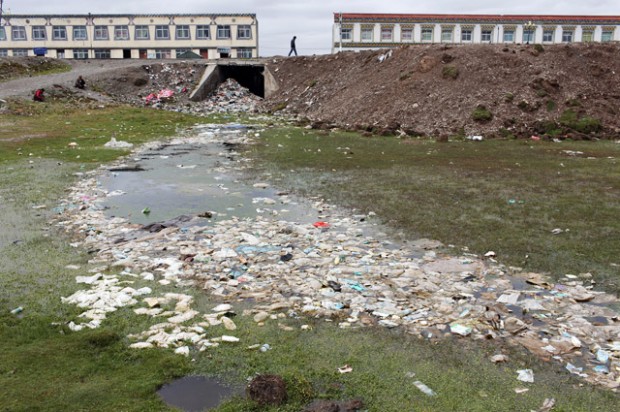Tibet is one of the World’s Cleanest Areas….Except in the places it Isn’t
A couple of news articles caught my attention last week regarding environmental conditions on the Tibetan Plateau that I wanted share with you. Regular readers here will know this a subject close to my heart having covered this issue in my project ‘Meltdown: Climate Change on the Tibetan Plateau‘, for the Pulitzer Center on Crisis Reporting in 2012.
The first article, Tibet is One of World’s Cleanest Areas, was the first to catch my attention on Oct 22nd. A Xinhua article, it reported that a new white paper released by the Information Office of the State Council claimed:
The Tibet Plateau is “the third-cleanest area in the world in terms of its environment,” after the South Pole and North Pole, says a white paper issued on Tuesday.
It continued…
“It has a clean and transparent atmospheric environment, and similar contents of pollutants to the North Pole,”…
Impressive claim. It concluded…
The white paper says the major rivers and lakes in Tibet maintain fine water quality, and the concentration of heavy metals is near the background level of global rivers and lakes ecosystem, indicating that they have not been polluted by human activities.

The idyllic image of the Tibetan Plateau?… The Dagu Glacier in northern Sichuan is rapidly disappearing as temperatures rise on the plateau faster than anywhere else in Asia.
Fast-forward 5 days and an article on the same site catches my eye. Garbage Piles up on the Qinghai-Tibet Highway.
Hmmmm Just when we were told everything was fine up there on the Plateau…
A huge amount of garbage has piled up on the Qinghai-Tibet highway on the Qinghai-Tibet plateau in west China, severely threatening the local ecology, an environment activist said in Beijing on Thursday.
Yang Xin, the president of Sichuan-based environmental group Green River, said that 40 volunteers cleared nearly 160,000 pieces of litter from a 450-kilometer section of the route touted as “The Road to Heaven” between October 12 and 18, as part of a garbage pollution survey initiated by the China Environmental Protection Foundation and Green River.
“We collected 63,602 plastic drink bottles, which was 40 percent of all the garbage collected,” Yang said, “There were also 43,546 aluminium cans, 27 percent; 25,588 plastic bages and wrappings, 16 percent; 7,416 glass bottles, 5 percent; 13,913 pieces of paper, 9 percent; and 5,122 pieces of metal, 3 percent. The total amount is 159,187 pieces.”
This is a phenomenon that I wrote about and photographed during my travels on the Plateau last year.
Pollution is rampant in urban areas as a result of communities being poorly educated about the importance of refuse collection and recycling. It is difficult to blame these communities though as most of the residents in this area are Tibetan herders, the majority of whom have been forced off the grasslands and into new urban communities. They know little of the practices of recycling and many of the townships in which they live are clearly neglected by authorities and refuse collection appears to be almost non-existent.
The Tibetan Plateau is an area of incredible natural beauty however pollution is now a significant issue in many areas. Apart from the pollution that is coming from increased development in the region, studies and articles point to many other environmental problems on the Plateau.
Toxic chemicals are accumulating in the ecosystems of the Himalayas and the Tibetan plateau, researchers warn in the first comprehensive study to assess levels of certain organic pollutants in that part of the world.
This from Scientific American in their article, Organic Pollutants Now Accumulating in Himalayas and Tibetan Plateau, looking in particular about the increase in s the spread of POPs, Persistent Organic Pollutants such as pesticides and herbicides that can evaporate after use and travel long distances on the wind.

A neglected ‘relocation village’ on the Qinghai-Tibet border. The village is home to nomads relocated from the highland grasslands.
…alarmingly, the researchers also detected large amounts of POPs in various components of the ecosystems such as soil, grass, trees and fish in the Himalayas and in the Tibetan plateau, especially at the highest elevations. “Their levels increase in orders of magnitude as they move further along the food chain,” says Xu. The amounts of DDT in leaves are up to four times higher than those found in boreal forests in the Arctic. “If the trend continues, the forests might reach a critical threshold in the next a few decades,” he says.
The moral of this post? Please be careful when you hear information telling you that all is well on the Plateau. The region faces many many challenges. To sugar-coat them or ignore them altogether leads to apathy and a failure to keep talking about one of the world’s most important regions.
Thankfully, groups like Green River are making a difference. After collecting an impressive 159,187 pieces, I just wonder how many are still lying there on the roof of the world.




comment 0